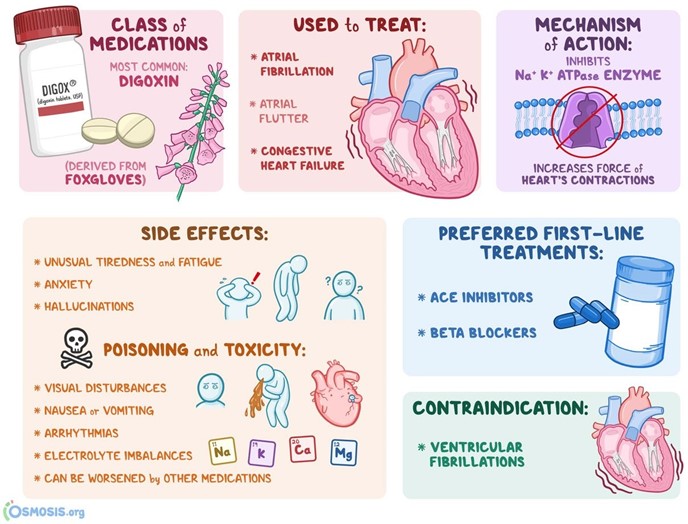Prior to giving digoxin, the practical nurse (PN) assesses that a 2-month-old infant's heart rate is 120 beats/minute. Based on this, what action should the PN take?
Administer the medication and alert the charge nurse
Hold the medication and document cardiac assessment
Administer the medication and document the heart rate
Hold the medication and recheck the heart rate in 1 hour
The Correct Answer is C
The correct answer and explanation is:
c) Administer the medication and document the heart rate.
This is the action that the PN should take prior to giving digoxin to a 2-month-old infant whose heart rate is 120 beats/minute. Digoxin is a cardiac glycoside that is used to treat heart failure and arrhythmias. It has a narrow therapeutic range and can cause serious side effects such as bradycardia, hypotension, and toxicity. Therefore, it is important to monitor the client's vital signs before and after administering the medication. A normal heart rate for a 2-month-old infant is 100–190 beats/minute, so 120 beats/minute is within the normal range and does not indicate a need to hold the medication. The PN should administer the medication as prescribed and document the heart rate and any other relevant findings.
a) Administer the medication and alert the charge nurse.
This is not the action that the PN should take prior to giving digoxin to a 2-month-old infant whose heart rate is 120 beats/minute. Alerting the charge nurse is not necessary, as the heart rate is normal and does not indicate a problem with the medication or the client's condition. The PN should administer the medication as prescribed and document the heart rate and any other relevant findings.
b) Hold the medication and document cardiac assessment.
This is not the action that the PN should take prior to giving digoxin to a 2-month-old infant whose heart rate is 120 beats/minute. Holding the medication is not appropriate, as the heart rate is normal and does not indicate a contraindication or a risk of adverse effects from the medication. The PN should administer the medication as prescribed and document the heart rate and any other relevant findings.
d) Hold the medication and recheck the heart rate in 1 hour.
This is not the action that the PN should take prior to giving digoxin to a 2-month-old infant whose heart rate is 120 beats/minute. Holding the medication and rechecking the heart rate in 1 hour is not necessary, as the heart rate is normal and does not indicate a need for further evaluation or intervention. The PN should administer the medication as prescribed and document the heart rate and any other relevant findings.
 |
Nursing Test Bank
Naxlex Comprehensive Predictor Exams
Related Questions
Correct Answer is ["A","B"]
Explanation
Choice A rationale:
Fresh or frozen vegetables without sauce. Rationale: Fresh or frozen vegetables without sauce are excellent choices for a client with hypertension. These foods are low in sodium and can help manage blood pressure effectively. The absence of added sauces ensures that there is no hidden sodium content.
Choice B rationale:
Fruits without sauce. Rationale: Fruits without sauce are also suitable for clients with hypertension. They are naturally low in sodium and provide essential nutrients that can support blood pressure control. The absence of sauce ensures that no additional sodium is added.
Choice C rationale:
Pickled olives. Rationale: Pickled olives are high in sodium due to the pickling process. Therefore, they are not recommended for clients with hypertension as they can lead to an increase in blood pressure.
Choice D rationale:
Canned soup. Rationale: Canned soup often contains high levels of sodium, which is not suitable for clients with hypertension. Excessive sodium intake can contribute to elevated blood pressure and should be avoided.
Choice E rationale:
Cottage cheese. Rationale: Cottage cheese is generally considered acceptable for clients with hypertension, especially if it is the low-sodium or reduced-sodium variety. However, it is not as strongly recommended as fresh or frozen vegetables and fruits without sauce.
Correct Answer is B
Explanation
Choice A rationale:
Diarrhea and flatulence are common side effects of statin medications like lovastatin but are typically not considered emergencies. They may be managed with dietary adjustments or over-the-counter remedies.
Choice B rationale:
Muscle pain, especially if severe, requires the most immediate follow-up by the nurse. Muscle pain can be a symptom of a rare but serious side effect called rhabdomyolysis, which can lead to muscle breakdown and potential kidney damage. Prompt assessment and intervention are necessary if severe muscle pain occurs.
Choice C rationale:
Altered taste is a side effect of lovastatin but is generally not considered a medical emergency. It may affect the client's quality of life but does not require immediate follow-up.
Choice D rationale:
Abdominal cramps may occur as a side effect of lovastatin, but they are not typically considered an emergency. Like choice A, abdominal cramps can often be managed with dietary adjustments or over-the-counter remedies.
Whether you are a student looking to ace your exams or a practicing nurse seeking to enhance your expertise , our nursing education contents will empower you with the confidence and competence to make a difference in the lives of patients and become a respected leader in the healthcare field.
Visit Naxlex, invest in your future and unlock endless possibilities with our unparalleled nursing education contents today
Report Wrong Answer on the Current Question
Do you disagree with the answer? If yes, what is your expected answer? Explain.
Kindly be descriptive with the issue you are facing.
